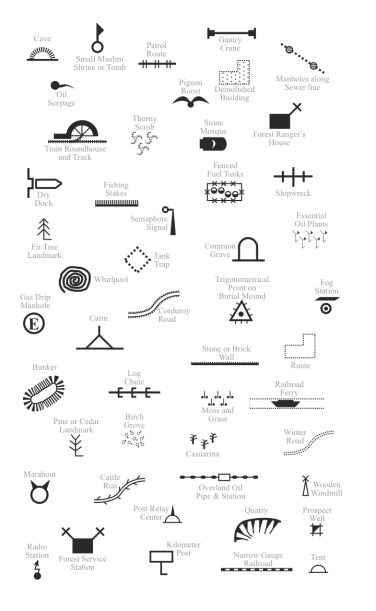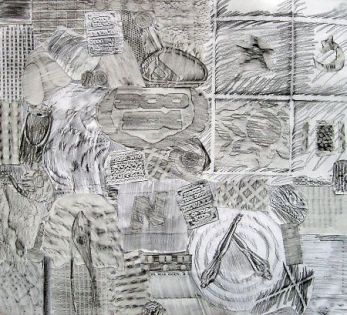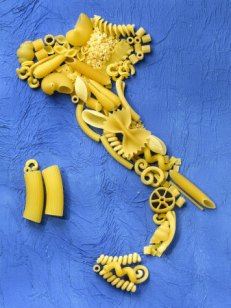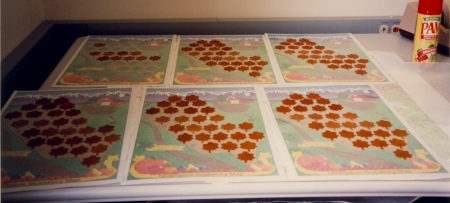
Guy Debord
PsychoGeography: “the study of the precise laws and specific effects of the geographical environment, consciously organized or not, on the emotions and behavior of individuals.”
PsychoGeography is…
- diverse activities that raise awareness of the natural and cultural environment around you
- attentive to senses and emotions as they relate to place and environment
- serious fun
- often political and critical of the status quo
Derive: aimless, random drifting through a place, guided by whim and an awareness of how different spaces draw you in or repel you.
Dérive: “A mode of experimental behavior linked to the condition of urban society: a technique of transient passage through varied ambiances.” Situationists used “ambiance” to refer to the feeling or mood associated with a place, to its character, tone, or to the effect or appeal it might have; but they also used it to refer to the place itself, especially to the small, neighborhood-sized chunks of the city they called unités d’ambiance or unities of ambiance, parts of the city with an especially powerful urban atmosphere. Wood “Lynch Debord.”

Guy Debord, Guide Pychogéographique de Paris
“The unities of ambiance appeared on the map as fragments of commercial street maps carefully cut out to indicate each unity’s defenses and exits. The psychogeographic slopes were symbolized by red arrows indicating the forces the city exerted on drifters freed from other motivations for moving: drifters would be pulled in the direction of the arrows from one unity of ambiance to another. The weight, shape, and patterning of the arrows indicated the lengths and strengths of the psychogeographic slopes.” Wood “Lynch Debord.“
Deep Thoughts on Psychogeography…
“Unfold a street map… place a glass, rim down, anywhere on the map, and draw round its edge. Pick up the map, go out in the city, and walk the circle, keeping as close as you can to the curve. Record the experience as you go, in whatever medium you favour.” Robert MacFarlane, Psychogeography: A Beginner’s Guide.
“The production of psychogeographic maps, or even the introduction of alterations such as more or less arbitrarily transposing maps of two different regions, can contribute to … complete insubordination of habitual influences. A friend recently told me that he had just wandered through the Harz region of Germany while blindly following the directions of a map of London.” Debord, Introduction to a Critique of Urban Geography.
“To derive was to notice the way in which certain areas, streets, or buildings resonate with states of mind, inclinations, and desires, and to seek out reasons for movement other than those for which an environment was designed.” Sadie Plant, The Most Radical Gesture.
“The sudden change of ambiance in a street within the space of a few meters; the evident division of a city into zones of distinct psychic atmospheres; the path of least resistance which is automatically followed in aimless strolls (and which has no relation to the physical contour of the ground); the appealing or repelling character of certain places–all this seems to be neglected.” Debord, Introduction to a Critique of Urban Geography.
“One or more persons committed to the derive abandon, for an undefined period of time, the motives generally admitted for action and movement, their relations, their labor and leisure activities, abandoning themselves to the attractions of the terrain and the encounters proper to it.” McDonough, “Situationist Space.”
“There’s a difference between knowing the Path and walking the Path.” The Matrix.
We are so tuned out, focused on getting through places for practical reasons (get to school, to work, etc.) that we don’t pay attention to places and the way all our senses and emotional awareness can be used to know these places.
What places attract us? Which repel us? Why?
•••••
Your Body as a Data Collection Device
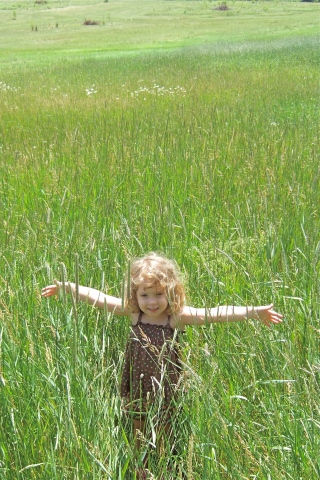
In front of me, on the desk where I write, I’ve assembled a bunch of instruments useful in measuring the environment, instruments that I’ve found around the house. In front of me, on the desk where I write, I’ve assembled a tape measure, a yardstick, a stopwatch, a watch, a goniometer and an arm protractor, a clinometer, a map measure, a compass, a wall thermometer, a pocket thermometer, a percentage protractor, a level, a plumb, a light meter, a camera, a pocket scale, a postage scale, a barometer, a measuring cup, a set of measuring spoons, a pedometer, a stud finder, and a passel of questionnaires. Some of them, like the pedometer, no longer work, but still I hold on to them. Others, like a couple of the questionnaires, never worked at all, but even these I am loathe to throw away. All of them have told me, or promised to tell me, something about my world, and since the world is something I’m eager to know about, I’m not eager to part with these instruments, functioning, flawed, or broken down. It’s 84º F where I sit at 11:30:36 in the morning. It’s nine minutes and forty-seven seconds since I typed the first word in this paragraph.
There’s another instrument in this room and I am it. I would have said it was stuffy where I sit and that half an hour had passed since I started writing, although my stop watch now says it’s been eleven minutes and thirty-eight seconds at, according to my other watch, 11:34 on the nose. I won’t argue with my instruments. They’re measuring different things than I. My thermometer knows nothing of the humidity oppressing me; my watches, recording the pressure of their drive springs, know nothing of the pressure of trying to say something with words.
Who should say which is superior instrumentation? Not I, certainly. My watches and I, we’re holding up the world against different standards, but both of these are interesting and valuable and important.
Wood “Lynch Debord.“
We are great data collection devices
- multiple senses with a broad range of capabilities
- Use of sight, sound, smell, taste, and touch all provide us with data about our environment
We supplement our senses with devices
- microscope helps us see things that are too small to normally see
- telescope helps us see things that are too far away
- “remote sensing” devices help us see what we cannot see: infrared energy
- but no device puts all the senses together the way humans do
- plus we are aware of emotion – fear, joy, excitement, terror
•••••
Mapping Emotions & Emotionscapes
Fear & Stress in an Urban (Philadelphia) Neighborhood. David Ley, 1972:

•••••
BioMapping: Christian Nold

GPS (Global Positioning System) + GSR: The Bio Mapping tool allows the wearer to record their Galvanic Skin Response (GSR), which is a simple indicator of emotional arousal in conjunction with their geographical location. This can be used to plot a map that highlights point of high and low arousal. By sharing this data we can construct maps that visualise where we as a community feel stressed and excited.
Greenwich Emotion Map (2005-06)
- emotional response with explanations (text)
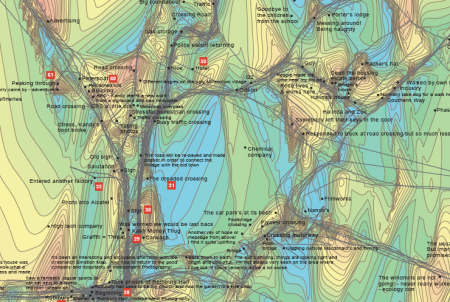
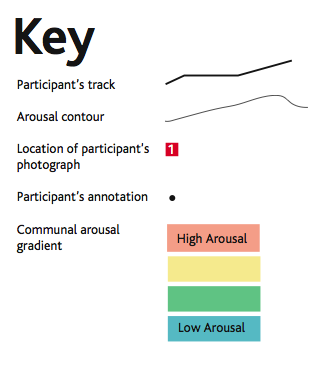 (source)
(source)

Emotional Cartography – Technologies of the Self. Edited by Christian Nold, 2009.
PDF of entire book here.
Resources
Emotions Defined (source):
- Accepted – regarded favorably
- Accepting – open or welcoming
- Agitated – troubled or nervous
- Alarmed – anxious or frightened awareness of danger
- Amused – entertained or laughing
- Angry – feeling or showing anger
- Angst – profound feeling of generalized anxiety or dread
- Annoyed – pestered; harassed; attacked repeatedly
- Anticipating – looking forward or expecting
- Anxious – experiencing worry or unease; very eager to do something
- Apprehensive – anticipating something with anxiety or fear
- Apathy – not interested or enthusiastic
- Aversion – strong dislike or disinclination
- Awed – feeling of great respect mixed with fear
- Bitter – feeling anger, hurt and resentment
- Bored – feel weary and uninterested by being dull and tedious
- Bewildered – perplexed or confused
- Betrayed – involving treachery, disloyal or break of trust
- Calm – peaceful and not showing nervousness, anger or other emotions
- Cautious – careful to avoid potential problem or danger
- Close – connected; united; bound together by strong relationship and common interest
- Comfortable – enjoying physical comfort
- Compassion – concern for the sufferings or misfortunes of others
- Complete – whole; doesn’t need anything
- Contented – in a state of peaceful happiness or satisfaction
- Confident – feeling certain in oneself or about something
- Confused – bewildered; having difficulty to understand
- Constrained – compel or forced towards a course of action
- Courageous – brave
- Depressed – feel utterly dispirited or dejected
- Disappointed – sad or displeased because one’s hopes or expectations have not been fulfilled
- Discontented – lack of satisfaction
- Disgusted – strong revulsion or indignation
- Desire – strong feeling of wanting to have something or wishing for something to happen
- Delightful – very pleased
- Determined – resolute; having firmness of purpose
- Distressed – extreme anxiety or suffering
- Doubtful – uncertain
- Drained – tired or used up completely
- Elated –
- Euphoric – intensely happy
- Embarrassed – feeling awkward, self-conscious or ashamed
- Emphatetic –
- Enjoying – taking pleasure in
- Ennui – listless and dissatisfied arising from boredom
- Enthusiasm – intense enjoyment, interest or approval
- Envious – resentful longing aroused by another’s possessions, quality or luck
- Ecstatic- subjecting to mystical experience
- Fearful – afraid
- Friendship – feeling of having a bond of mutual affection but not sexual
- Frustrated – unfulfilled
- Glee – great delight
- Glad – pleased; grateful
- Gratitude – thankful
- Greed – intense and selfish desire for food, wealth or power
- Grief – intense sorrow especially caused by someone’s death
- Guilty – feeling of being responsible for a wrongdoing, fault or error
- Hate – feeling of hatred or intense dislike towards
- Happy – having pleasure or contentment
- Homesick – feeling upset because one is missing one’s home
- Honored – feeling of pride and pleasure from being shown respect
- Hope – feeling of expectation and desire for something to happen
- Horror – intense feeling of fear, shock or disgust
- Humbled – modest or low estimate of one’s own importance
- Hurt – mental pain or distress
- Impatient – lacking patience or tolerance
- Inadequate – unable to deal with a situation or life
- Indignant – annoyance provoked by what is perceived as unfair treatment
- Interested – wanting to know about something or someone
- Irritated – annoyed
- Isolated – remote; lonely
- Joyful – feeling of great pleasure and happiness
- Jealous – resentful of someone regarded as a sexual rival; fiercely fighting for attention
- Lonely – sad because one has no friends or company; solitary; unfrequented and remote
- Love – intense feeling of deep affection; deep romantic or sexual attachment to someone
- Lust – strong sexual desire
- Mad – extremely foolish or ill-advised; very enthusiastic about something
- Melancholy – deep and long lasting sadness
- Modest – unassuming in the estimation of one’s abilities; relatively moderate; decent
- Misunderstood – fail to be understood correctly; misjudged
- Naive – lacking experience, wisdom and judgement
- Nervous – apprehensive; easily agitated or alarmed
- Negative – pessimistic; undesirable; denial; unwelcome; expressing disagreement or refusal
- Nostalgic – sentimental longing or wishful affection for the past
- Pain – mental suffering or distress
- Panic – sudden uncontrollable fear or anxiety; informal frenzied hurry to do something
- Patient – having or showing patience
- Peaceful – free from disturbance; calm; inclined to avoid conflict
- Phobia – irrational fear of something
- Pity – feeling of sorrow and compassion caused by sufferings of others
- Pleasure – feeling of happy satisfaction and enjoyment
- Proud – deep pleasure or satisfaction derived from achievement, qualities, possessions; excessively high opinion of oneself;
- Rage – violent uncontrollable anger
- Regret – express sorrow, repentance or disappointment
- Remorseful – deep regret or guilt for a wrong committed
- Resentful – feeling of bitterness or indignation
- Sad – unhappy; feeling sorrow
- Satisfied – met expectations, needs or desires
- Self-pity – excessive concern with and unhappiness over one’s own troubles
- Shame – feeling of humiliation caused by awareness of wrong or foolish behavior; loss of esteem
- Shy – timid in the company of others; slow or reluctant to do; specified dislike or aversion
- Shock – feeling caused by sudden upsetting or surprising event or experience
- Suffer – experience something bad or unpleasant
- Surprised – mild astonishment caused by something unexpected
- Suspense – feeling of excited or anxious uncertainty about what may happen
- Sympathetic – showing sympathy or approval of an idea, action, sentiment or opinion
- Terrified – feel terror or extreme fear
- Tired – exhausted the patience or interest of; feeling drained; bored
- Troubled – worried of inconvenience; problematic
- Trust – firm belief in reliability, truth, ability or strength of someone or something
- Understanding – sympathetically aware of other people’s feelings
- Vulnerable – feeling exposed to being attacked or harmed
- Wonder – feeling of surprise or admiration caused by something beautiful, unexpected or unfamiliar
- Worried – anxious or troubled over actual or potential difficulties
- Wrathful – intense anger
- Yearning – intense feeling of loss and longing for something
- Zestful – great enthusiasm and energy
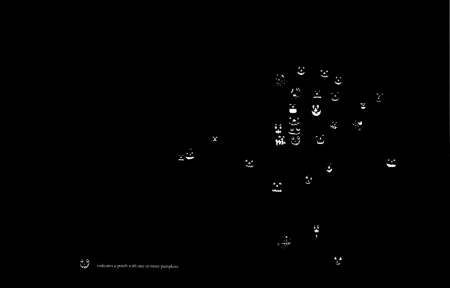
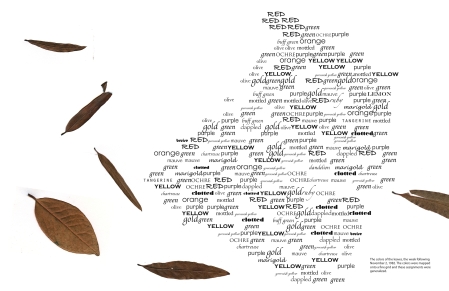
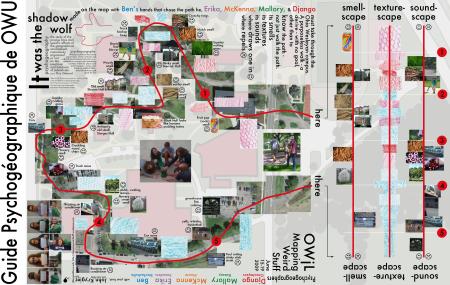



 Posted by John Krygier
Posted by John Krygier 
















